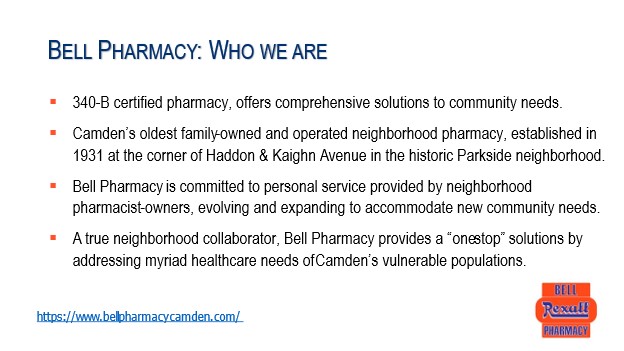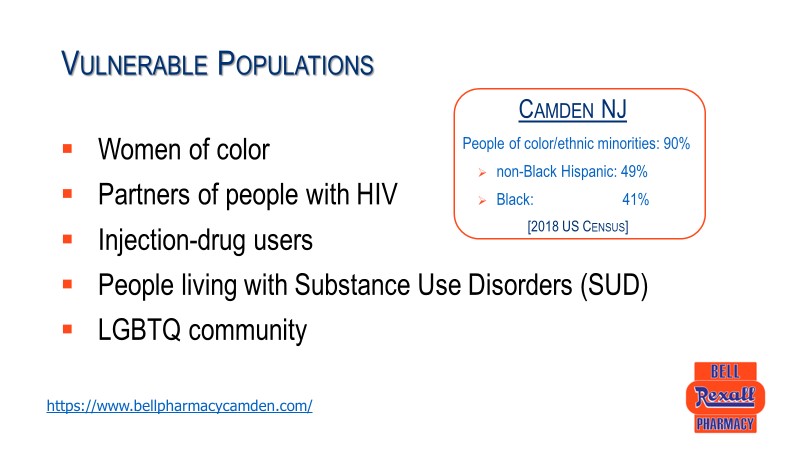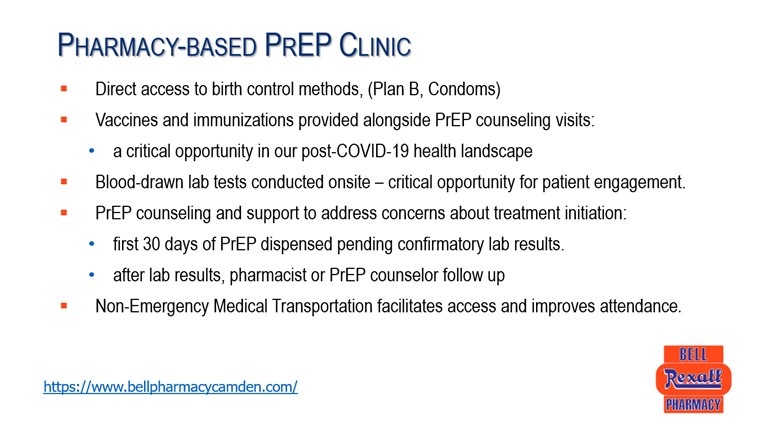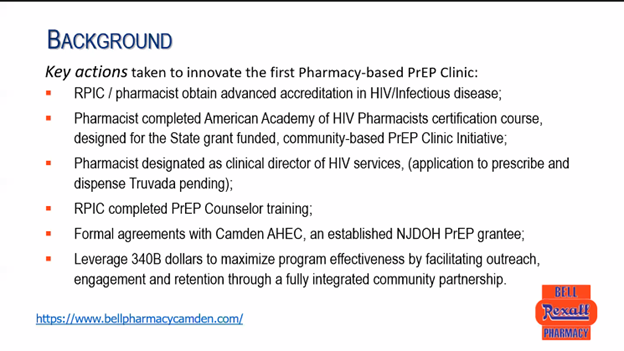Quality Forum Review: Barriers to Care: A Pharmacy-Based Pre-Exposure Prophylaxis (PrEP) Model
The PQA Quality Forum Webinar is a regular, recurring series on healthcare quality topics with a focus on medication use and medication services. It is a forum for educating and engaging with PQA members and quality-focused healthcare professionals.
PQA’s August 19, 2021, Quality Forum welcomed Anthony V. Minniti, RPh, FACA, from Bell Pharmacy in Camden, N.J., to discuss Bell Pharmacy’s Pre-Exposure Prophylaxis (PrEP) Model. Bell Pharmacy, a 2021 Community Pharmacy Innovation in Quality (CPIQ) Award recipient, implemented this model in the beginning of 2020 to better serve their community.
Minniti explained how his pharmacy has implemented the PrEP Model and provided insight into how other pharmacies could build innovative service models.

Step 1: Assess community needs and opportunities for services.
If you are interested in learning more about integrating quality measurement and HIV treatment and prevention, PQA has a new continuing education course, “Measuring Quality to Improve HIV Medication Use.” The program is provided online through the PQA Education Center. See our tutorial for accessing the program and our frequently asked questions. Learn more about the Medication Use Quality continuing education program on PQA’s website.As Camden’s oldest family-owned and operated neighborhood pharmacy, established in the historic Parkside neighborhood, Minniti and his colleagues assessed their patient population to identify preventive treatment services from which their community would benefit.

While Truvada was FDA approved for PrEP treatment in 2012, integration and adoption into clinical practices did not become popular until 2017 as more data regarding effectiveness and safety emerged, according to Minniti. It was then Minniti visualized how Bell Pharmacy could play a key role in preventative therapy of HIV and contribute to New Jersey Department of Health’s goal of 75% reduction in new HIV cases by 2025.Bell Pharmacy services vulnerable populations including women of color, partners of people living with HIV, injection-drug users, people living with substance use disorders (SUD) and members of the LGBTQ community. Over 90% of residents in the Camden community are people of color or ethnic minorities.
Step 2: Choose a service that addresses community needs.
Bell Pharmacy implemented the nation’s first Pharmacy-Based PrEP Clinic Practice Model (PCPM) to address the quadruple aim and to fill quality and patient care gaps in vulnerable populations. Bell Pharmacy acts as a one stop hub for health education, clinical services, PrEP treatment, and care coordination.
Step 3: Identify key partners that serve the same patient population.
After conceptualization, Bell Pharmacy partnered with the Camden Area Health Education Center (AHEC). Camden AHEC, an established New Jersy Department of Health PrEP grantee, has the resources and skills to go out into the community to address any social and environmental factors that can impact a patient’s care. They are instrumental in re-establishing contact with patients when there is a change of address or phone number to ensure that there are no gaps in care.
Step 4: Consider what other services you already offer that can complement your new service.
By housing the PrEP clinic within the pharmacy, Minniti explained that healthcare professionals are equipped to address more than PrEP treatment services. They can also address needs pertaining to SUD, risk management strategies, naloxone counseling and prescriptions, sexually transmitted infections (STI) testing and treatment, safe syringe programs, contraceptives, as well as connecting patients with a dedicated PrEP counselor. On the side is a list of additional services Bell Pharmacy provides to their community.
Step 5: Identify any additional training or certifications staff may need to implement and provide new services.
To ensure patients received high quality care, pharmacists completed advanced HIV training certificate programs. Minniti also completed PrEP Counselor Training which focused on the social and environmental considerations for vulnerable populations.
Step 6: Refine service models to optimize impact on all partners involved in patients’ care.
The PrEP Counselor Training also highlighted the needs of social workers and how Bell Pharmacy could better engage with Camden AHEC. Bundling services such as medication dispensing, patient counseling, labs, and additional services into one visit made it much easier for social work to coordinate transportation for patients rather than having four separate encounters.
Furthermore, this training highlighted that a patient could feel more at ease going to a pharmacy for STI or PrEP treatment compared to an HIV clinic because there is less stigma associated with visiting a neighborhood pharmacy. This helps dissipate fear of losing confidentiality in treatment.
Step 7: Identify staff and partner responsibilities. Highlight and discuss any changes in existing workflow for staff.
While implementing a new service can seem daunting, some of the tasks involved in the PCPM are tasks pharmacies are already doing. These tasks include requesting refills from prescribers, communicating to patients when labs are needed, dispensing PrEP therapy, delivering prescriptions, counseling patients on medication side effects, and assessing immunization history.
Additionally, with Camden AHEC executing patient outreach in the community, Minniti created a process for pharmacy staff to inform Camden AHEC about issues reaching patients. Camden AHEC then went out into the community, found patients, collected new contact information, and provided that back to the pharmacy. This was crucial in allowing Bell Pharmacy to continue communicating with patients through texts.
Step 8: Identify desired outcomes to assess quality of care prior to implementation and continually collect data needed for outcomes.
PCPM outcomes assessed included patient awareness of HIV/STI status, eligible patients initiated on PrEP treatment, and percent of patients who received refilled prescriptions at 6 months for PrEP therapy. At Bell Pharmacy, 15 patients received care in the PCPM. Out of those 15 patients, all knew their HIV/STI status, were eligible for and initiated PrEP therapy and continued to be on medications six months after beginning treatment.
Step 9: Anticipate challenges or barriers and adjust the care model as needed.
While the model is successful and expanding, there were some challenges that Bell Pharmacy faced. The COVID-19 pandemic was emerging as they implemented the PCPM, making it harder to perform community outreach and in-person care visits. However, Bell Pharmacy provided telehealth visits, prescription delivery, and communicated with other healthcare providers about patient’s care in a safe way to ensure no gaps in medication therapy occurred.
Step 10: Consider sustainably adding new services, community partners and/or patients that receive existing services.
Moving forward, Bell Pharmacy will continue to grow PCPM by expanding services such as immunizations and STI and Hepatitis C testing for patients. By building relationships with patients through PCPM and other services, Bell Pharmacy hopes to seize the opportunity to be the central hub managing their patient’s entire healthcare plan while remaining very accessible to their community.
You can listen to the full recording of this Quality Forum Webinar, a one-hour presentation with audience Q&A, on PQA’s YouTube channel. PQA members can access the presentation slides in our Member Resources Library.
If you are interested in learning more about integrating quality measurement and HIV treatment and prevention, PQA has a new continuing education course, “Measuring Quality to Improve HIV Medication Use.” The program is provided online through the PQA Education Center. See our tutorial for accessing the program and our frequently asked questions. Learn more about the Medication Use Quality continuing education program on PQA’s website.
